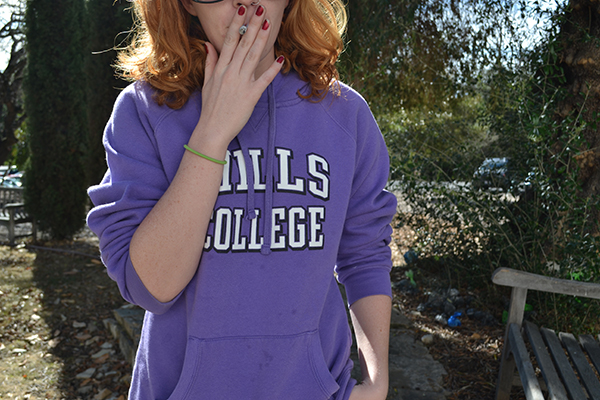
UC Berkeley was proclaimed a tobacco-free campus Jan. 1, employing the simple campaign slogan: “Breathe.” Elsewhere, Mills College’s once rampant discussions about creating a “smoke-reduced campus” are now stagnant.
In 2011, the Associated Students of Mills College (ASMC) discussed creating a “smoke-reduced” atmosphere by designating 10 smoking zones on campus. Then-ASMC-President Modesta Tamayo and Vice President Rebecca Freeman spear-headed the effort in conjunction with the Smoking Committee, a group that formed around the same time to handle best practices surrounding smoking on campus. They planned to submit their final decision to Mills faculty as a strong recommendation for how the campus smoking policies should be modified.
However, the smoking policy was never officially altered, and discussions about the policy abruptly dwindled to a moot point with the departure of Tamayo and Freeman. Currently, the policy still stands–students can smoke anywhere on campus with the exception of the Art building and the Children’s School, and are not permitted to smoke within 30 feet of any building entrance.
“[These meetings were] a combination of interested parties, smokers and non-smokers, and the wellness coordinator at the time,” said Linda Zitzner, head of Facilities and co-chair of the Smoking Committee.” But the wellness coordinator left and the Smoking Committee kind of fell apart, so we don’t really have anything formal going on right now.”
Zitzner explained that with a campus of 1500 college students, placing regulations on smoking has the potential to present a myriad of challenges.
According to Annie Neves, co-chair of Mills’ Smoking Committee and Executive Assistant to the Dean of the School of Education, when she came on as co-chair of the Smoking Committee with Linda Zitzner, the entire education complex, including the children’s school and the art department area had elected to be smoke-free zones. But, a consensus was never reached on whether or not to establish “smoking islands” because there was little to no funding to accommodate them with tables and benches. Now, Neves does not believe anyone feels up to tackling the smoking issue.
“Things just fizzled out last year and I think people just sort of refocused on other things,” Neves said. “I would love to see Mills go smoke-free, so I don’t understand what the hold up is. It would cost nothing except to put together a proposal and send it to the Board of Trustees.”
While there are no plans to change the current smoking policy on campus, some students still strongly feel that changes should be happening for the health of themselves and other students. Sophomore Lily Leighton, a non-smoker and nursing student, said that she was surprised to find an abundance of smokers upon her arrival to Mills.
“I think that having some sort of new guidelines, like where you can and cannot smoke, would be nice because some people who don’t smoke don’t want to smell cigarette smoke as they walk from class to class,” Leighton said. “Maybe if there were some guidelines in place, it would discourage people from smoking in between classes as much because it’s gross when a student in a class makes the whole room smell like cigarette smoke.”
Senior Casey Honath, who does not smoke cigarettes, feels that smoking on campus is okay, but it should be confined to spaces that are “off the beaten path” where non-smokers won’t have to come directly into contact with the smoke.
“I am sensitive to cigarette smoke and I know many other students at Mills who are,” Honath said. “I find it inconsiderate of smokers who smoke on common paths and blow smoke into the air.”
Sophomore Julia Taylor-Brown, who smokes frequently, believes that where people smoke on campus is an unrealistic thing to control, but the policy as it stands is not a problem.
“[Mills] does a really good job of accommodating for smokers, giving them places to put the butts, reasonable signage and rules,” Taylor-Brown said. “Everyone knows the rules and I’d say most people abide by it.”

Taylor-Brown also believes that smokers at Mills are generally considerate about where they choose to smoke, even though smoking happens between classes and the smell of a cigarette is not an uncommon one around campus.
“I know the rule is 30 feet away from the door, so I really try to make sure that I’m away from that,” Taylor-Brown said. “It’s legal everywhere else in public places, and I feel that even though this is a private campus, we should treat it with public rules.”
Similarly, senior Kelly Dingman, who smokes daily, believes that Mills’ smoker population is not infringing on the space of non-smokers.
“I feel like there aren’t many smokers on campus, and the people that do make it a point not to smoke in Adam’s Plaza or right in front of NSB,” Dingman said. “They’re not right in people’s faces.”
A large concern for non-smokers is the amount of secondhand smoke that is inhaled from nearby cigarettes. Not only could some students be allergic to the smoke, it also affects the health of students in the vicinity. A statement on UC Berkeley’s Tobacco Free Campus website insists that not only does a tobacco-free campus “support tobacco users who are trying to quit,” it also “reduces the number of new tobacco users by promoting the social norm of a tobacco free environment.”
Neves said she was surprised that UC Berkeley had enacted a tobacco-free policy because they are a state school while Mills, a private institution, has failed to jump on the smoke-free bandwagon.
“There are schools in the deep South, in the tobacco belt, that have gone smoke-free,” Neves said. “If they can do that, why can’t we? We could be an example.”
Students can discuss this topic at an open forum on March 5 from 4:30-6pm in the Student Union. The forum will be lead by Mills’ Wellness Action Group.
